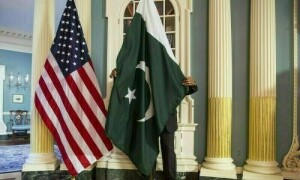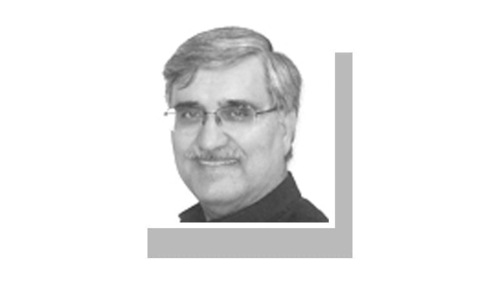United States President Donald Trump has introduced tariffs on exports from dozens of trading partners, including a 19 per cent tariff on Pakistani goods — revised from the previous 29pc — a day after the two countries finalised a trade agreement.
According to an executive order detailing the tariffs, it was announced that Pakistan is set to face a 19pc tariff rate as Trump’s tariff deadline comes to an end on August 1 (today).
The order listed higher import duty rates of 10 to 41pc starting in seven days for 69 trading partners as the 12:01am EDT (9:01am PKT) deadline approached.
What we know so far:
- Pakistani goods exported to US to now be taxed 19pc as part of Trump’s global tariffs
- The rate is lower than the proposed 29pc after trade talks with US
- Finance ministry sees major opportunity to expand Pakistan’s footprint in US market
- Official notes Pakistan ‘possibly only country’ offered investments alongside
- Levies for 68 other trading partners range from 10-41pc, with India facing 25pc tariff
- Canada’s duties raised to 35pc; Brazil slapped with 50pc; China facing Aug 12 deadline
Late on Wednesday night, a Pakistani delegation led by Finance Minister Muhammad Aurangzeb in Washington, DC, finalised a trade agreement with the US, expected to lower tariffs, although no figure was announced. Trump also said Washington would help Islamabad develop “massive oil deposits”.
In its statement issued today, the finance ministry said the government was “pleased to announce the successful conclusion of tariff-related discussions” with the US.
“As per the outcome of these talks, a tariff of 19pc will be applicable for Pakistani exports to the US market,” it said.
The statement noted that the decision reflected a “balanced and forward-looking approach by the US authorities, keeping Pakistan competitive relative to other South and Southeast Asian countries”.
“In particular, this tariff level is expected to support Pakistan’s export potential, especially in key sectors such as textiles, which remain the backbone of the country’s export economy,” the ministry highlighted.
In the first 11 months of the outgoing fiscal year (FY), exports to the US rose by 11.06pc to $5.552 billion from $4.999bn a year earlier. In FY24, Pakistan’s textiles exports to the US reached $5bn representing 92pc of its overall exports to that country.
The ministry said it belived that the current tariff arrangement presented a “significant opportunity to expand Pakistan’s footprint in the US market”. “It is now essential for Pakistani exporters and trade bodies to adopt an aggressive and focused marketing strategy to capitalise on this development,” it stressed.
The ministry also pointed out a “substantial potential for growth in other sectors”, affirming that the government was committed to facilitating exporters through policy support, market intelligence and trade promotion initiatives.
“The Government of Pakistan looks forward to further positive engagements and close cooperation with the United States in the areas of investment, artificial intelligence, cryptocurrency, mines & minerals, energy, and other emerging sectors.
“Pakistan will continue to engage closely with President Trump and the US administration to promote the shared goals of economic development and mutual prosperity,” the statement asserted.
It appreciated the “constructive engagement” of the US authorities and acknowledged the valuable role played by its team, including the commerce ministry and the Pakistan Mission in Washington DC, and other public and private sectors stakeholders.
In a recorded video statement, Aurangzeb said he and his team had a “very constructive final round of discussions” with US Commerce Secretary Howard Lutnick and Trade Representative Jamieson Greer, which the “led to finalising the trade deal”.
“Trade and investment have to go hand in hand,” the finance czar stressed, adding that the “bilateral and strategic partnership has come up prominently”.
Giving insights on the process, the minister pointed out the private sector’s role as it was the “first constituent” to volunteer in helping to reduce the trade imbalance.
Terming it a “win-win situation” again for the future, Aurangzeb said: “I think we are in a good place today […] in terms of where we have arrived before August 1.”
Pakistan has emerged with the second-lowest tariff rate of any South Asian country. Afghanistan got hit with a 15pc levy, Bangladesh, Sri Lanka and Vietnam with 20pc, and India with 25pc.
CNN noted: “There is also satisfaction locally that Pakistan’s tariff rate is much lower than neighbour and arch-rival India’s. Fears in Islamabad that India was trying to isolate Pakistan financially have been somewhat tempered by the 25pc tariff rate that the Trump administration hit New Delhi with.”
Meanwhile, the Pakistan Stock Exchange (PSX) maintained its bullish momentum and crossed the 141,000-point barrier, despite dipping by as many as 433 points in the morning.
The benchmark KSE-100 index rose by 1,644.56 points (1.18pc) to reach a intraday high of 141,160.93 points at 4:11pm, from the previous close of 139,390.42 points. It finally closed at 141,034.98 points.
Having witnessed heavy selling pressure on Tuesday due to corporate earnings and political noise, the PSX had bounced back above the 139,000-mark yesterday, driven by the trade agreement with the US.

Pakistan ‘possibly only country’ offered investments as well
Adviser to the Finance Minister Khurram Schehzad highlighted on X: “Pakistan is possibly the only country which the US has offered its investments as well, besides a competitive trade deal.”
He noted the “deal signals a strategic deepening of economic ties and shared growth”.
Speaking to Geo News, Schehzad expanded upon possible US investment in Pakistan’s energy sector, which he termed the “biggest area” in the economy.
“We need global partnerships in energy. We import 80-90pc of all our energy needs,” the finance minister’s adviser observed.
“If such an economy — a giant which has expertise in oil and gas — if they’re coming and talking about massively building oil and gas reserves, so we can export to the entire region, not just fulfil our own needs, this is a big development,” the adviser emphasised.
“If Pakistan make a deal with the US to set up big plants for exploration or machinery, we’ll get benefits in tariffs through that as well,” he added.
“The way Pakistan has been treated compared to different countries in this region, very encouraging and important,” Schehzad said, referring to the higher 25pc levy imposed on India.
While noting that the government’s role was to negotiate and secure a good deal, he called on the private sector to execute it through business-to-business, export contracts, and export engagement.
“The import bill can be reduced, the dollar can be impacted, overall employment generation, and GDP can be improved,” Schehzad highlighted.
He pointed out that the Pakistani companies, such as Oil and Gas Development Company Limited (OGDCL) and the Pakistan Petroleum Limited (PPL), were stakeholders in Balochistan’s Reko Diq mining project.
‘Failed to align sufficiently’
Trump set rates including a 35pc duty on many goods from Canada, 50pc for Brazil, 25pc for India, 20pc for Taiwan and 39pc for Switzerland, according to a presidential executive order.
Some of them had reached tariff-reducing deals; others had no opportunity to negotiate with his administration. Trump included an exception for some goods shipped within the coming week.
Goods from all other countries not listed would be subject to a 10pc US import tax. Trump had previously said that the rate might be higher.
The administration also teased that more trade deals were in the pipeline as it seeks to close trade deficits and boost domestic factories.
According to the executive order, if a trading partner fails to take “adequate steps” to address the tariffs or retaliates against the US, the commerce secretary and trade representative, in coordination with the appropriate senior officials, shall recommend additional action.
Facing a Friday deadline of his making, the Republican president has tapped emergency powers, pressured foreign leaders, and pressed ahead with trade policies that sparked a market sell-off when they were first announced in April.
This time, markets had a more muted reaction. Stocks and equity futures fell modestly in Friday morning trading in Asia.
Trump’s order said that some trading partners, “despite having engaged in negotiations, have offered terms that, in my judgment, do not sufficiently address imbalances in our trading relationship or have failed to align sufficiently with the United States on economic and national-security matters”.
Other details are still to come, including on the “rules of origin” that will determine what products might face even higher tariffs.
Trump also said “we have made a few deals today that are excellent deals for the country”, and a US official later told reporters that they were still to be announced.
Canada, Mexico
Trump issued a separate order for Canada that raises the rate on Canadian goods subject to fentanyl-related tariffs to 35pc, from 25pc previously, saying Canada had “failed to cooperate” in curbing illicit narcotics flows into the US.
The higher tariffs on Canadian goods contrasted sharply with Trump’s decision to grant Mexico a 90-day reprieve from higher tariffs of 30pc on many goods to provide more time to negotiate a broader trade pact.
Trump complained to reporters earlier that Canada had “been very poorly led”.
Canadian Prime Minister Mark Carney said he was disappointed by Trump’s decision.
“While we will continue to negotiate with the United States on our trading relationship, the Canadian government is laser focused on what we can control: building Canada strong,” Carney said in a post on X.
US duties and tariffs will heavily affect lumber, steel, aluminium, and automobiles, he added, vowing action to protect Canadian jobs, buy Canadian goods, invest in industrial competitiveness and diversify export markets.
The extension for Mexico avoids a 30pc tariff on most Mexican non-automotive and non-metal goods compliant with the US-Mexico-Canada Agreement on trade and came after a Thursday morning call between Trump and Mexican President Claudia Sheinbaum.
“We avoided the tariff increase announced for tomorrow,” Sheinbaum wrote on X, adding that the Trump call was “very good”.
About 85pc of US imports from Mexico comply with the rules of origin outlined in the USMCA, shielding them from 25pc tariffs related to fentanyl, according to Mexico’s economy ministry.
Trump said the US would continue to levy a 50pc tariff on Mexican steel, aluminum and copper and a 25pc tariff on Mexican autos and on non-USMCA-compliant goods subject to tariffs related to the US fentanyl crisis.
“Additionally, Mexico has agreed to immediately terminate its Non-Tariff Trade Barriers, of which there were many,” Trump said in a Truth Social post, without providing details.
India discord
Goods from India appeared to be headed for a 25pc tariff after talks bogged down over access to India’s agriculture sector, drawing a higher-rate threat from Trump that also included an unspecified penalty for India’s purchases of Russian oil.
Although negotiations with India were continuing, New Delhi vowed to protect the country’s labour-intensive farm sector, and the threat of higher rates from Trump triggered outrage from the opposition party and a slump in the rupee.
Without a deal, the rate will go into effect from Friday and single out India for harsher trade conditions than its major peers, potentially damaging the economy of a strategic US partner in Asia seen as a counterbalance to Chinese influence.
Trump’s rollout of higher import taxes comes amid more evidence they have begun driving up consumer goods prices.
Commerce Department data released on Thursday showed prices for home furnishings and durable household equipment jumped 1.3pc in June, the biggest gain since March 2022. Recreational goods and vehicles prices shot up 0.9pc, the most since February 2024. Prices for clothing and footwear rose 0.4pc.

Brazil slapped with 50pc tariff; China facing Aug 12 deadline
Trump hit Brazil’s exports on Wednesday with a steep 50pc tariff as he escalated his fight with Latin America’s largest economy over its prosecution of his friend and former president Jair Bolsonaro, but softened the blow by excluding sectors such as aircraft, energy and orange juice from heavier levies.
The run-up to Trump’s tariff deadline was unfolding as federal appeals court judges sharply questioned Trump’s use of a sweeping emergency powers law to justify his sweeping tariffs of up to 50pc on nearly all trading partners.
Trump invoked the 1977 International Emergency Economic Powers Act to declare an emergency over the growing US trade deficit and impose his “reciprocal” tariffs and a separate fentanyl emergency.
The Court of International Trade ruled in May that the actions exceeded his executive authority, and questions from judges during oral arguments before the US Appeals Court for the Federal Circuit in Washington indicated further scepticism.
Meanwhile, China is facing an August 12 deadline to reach a durable tariff agreement with Trump’s administration, after Beijing and Washington reached preliminary deals in May and June to end escalating tit-for-tat tariffs and a cut-off of rare earth minerals.
A US official told reporters that they are making progress toward a deal.












































